

William Stopford
The cars axed in 2025 that we'll miss the most
20 Hours Ago
The best electric sports car on the planet? That's the aim of the heavily revised 2024 Porsche Taycan, but can it deliver?
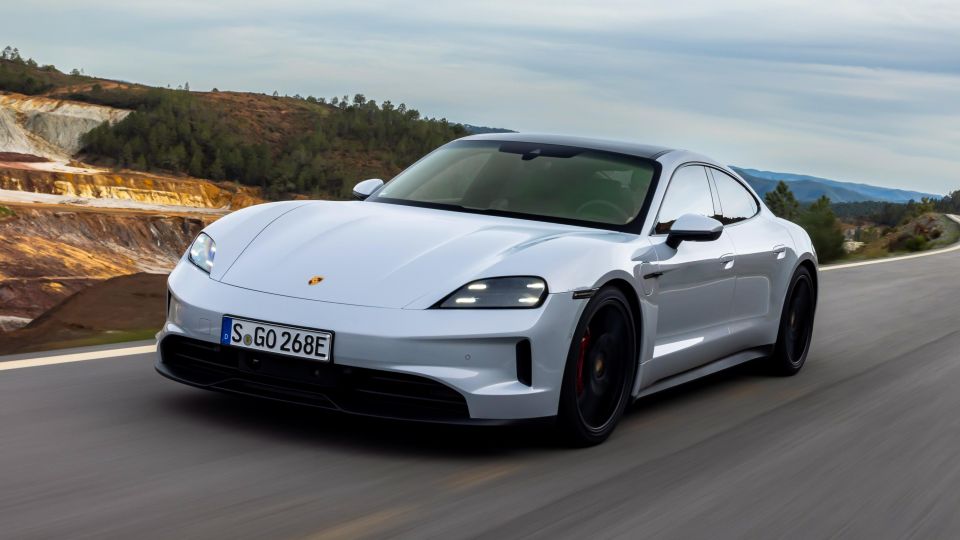
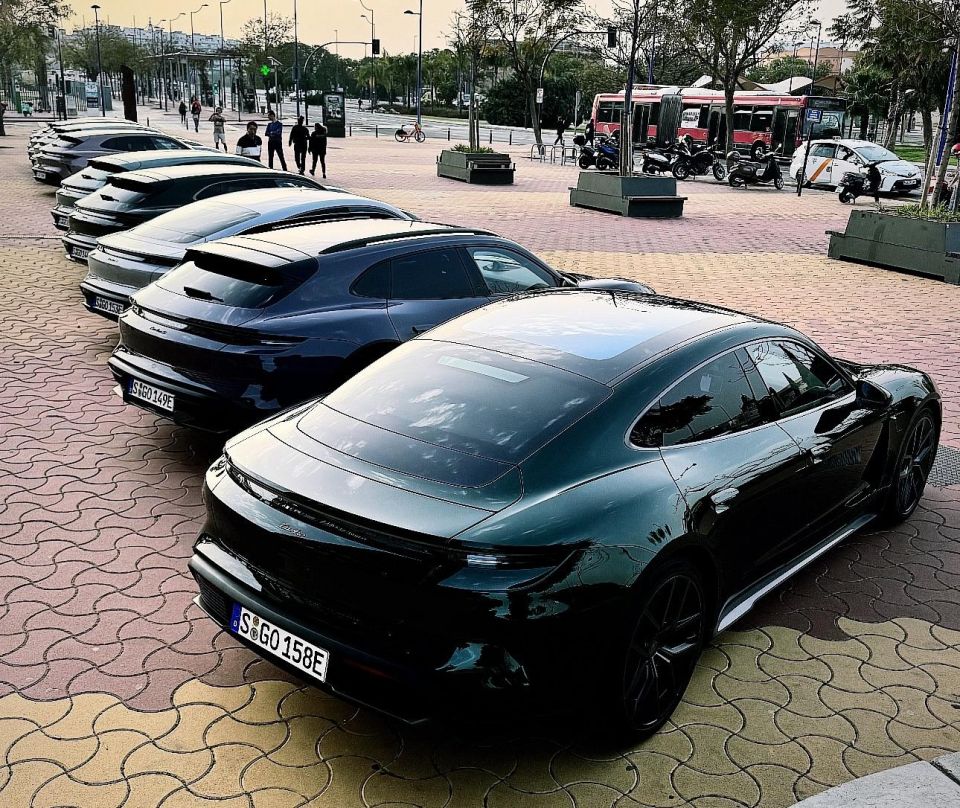

Quickly see how this car stacks up against its competition. Select any benchmark to see more details.
Where expert car reviews meet expert car buying – CarExpert gives you trusted advice, personalised service and real savings on your next new car.
The 2024 Porsche Taycan presents the most compelling case yet for why luxury electric vehicles (EVs) are market ready. Now with up to 35 per cent longer range, faster charging times, massively improved performance and better ride quality, the new Taycan has once again reset the class benchmark.

The updated Porsche Taycan may appear like a minor facelift from the outside, but the improvements are so substantial that it could be regarded as an all-new model – which it would be if Porsche didn’t want to annoy its existing customers.
When the original (J1 I) Taycan came out in 2019, it was a statement of intent that Porsche was looking to move towards electrification. As it stands, the German sports car maker believes 80 per cent of its sales will be electrified by 2030, and the 911 will be the only model offered without electrification by 2035.
Despite the doom and gloom you may have heard regarding the slowdown in EV uptake, the reality is more EVs are sold now than ever before and while some brands have found it more challenging than initially expected, this is largely due to the price of the vehicles being higher than their customers are used to.
Porsche does not have that problem, and having sold over 140,000 first-generation Taycans, it will have no issue selling more of the significantly improved model.
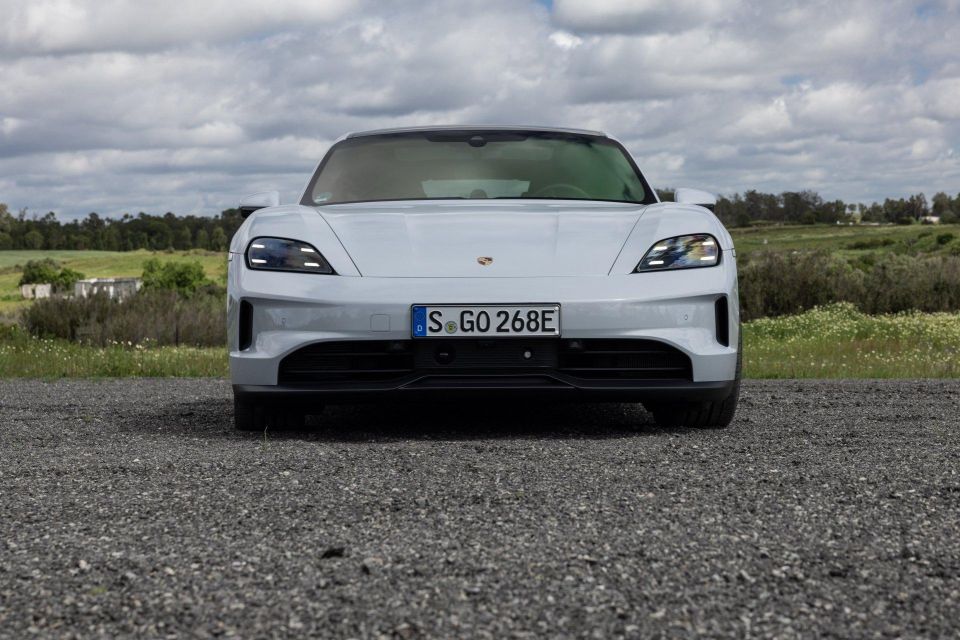
Following the new (J1 II) Taycan, Porsche is backing it up with an all-new and fully electric Macan later this year, which will set the path for the electric 718 Cayman/Boxster and electrified Cayenne in due course.
For those who don’t know their Taycans, spotting the new model from the old will be challenging. Porsche says the similarity between the two is to avoid unnecessarily depreciating the original Taycan – which to be fair, has on average depreciated more than any other Porsche model in the lineup.
Nonetheless, if you look closely, there are a fair number of subtle design changes. Firstly and perhaps most obviously, the new headlights and tail lights.
Head-on, the new front wings and the flatter headlights are meant to accentuate the width. The new headlights are also available with high-resolution HD matrix technology, although this is optional on most variants.

The now-illuminated Porsche logo in the rear light strip features a three-dimensional, glass-look design that plays a preset light show on entry and exit. Perhaps the most useful exterior improvement is the addition of charging ports on both sides of the vehicle.
The interior remains largely unchanged however a great deal of the graphics have been updated to give better indication of what the vehicle is doing and how well it is charging.
The mode switch on the steering wheel has been made standard and if you tick the Sport Chrono option, there is a new push-to-pass button which gives additional performance for a short period of time.
The new Porsche Taycan has seen a price rise over the outgoing model, but the increase in standard equipment offsets the extra costs.

2024 Porsche Taycan pricing
Prices exclude on-road costs
To see how the Taycan compares with its rivals, use our comparison tool.
Buy your new car without the stress. It's fast, simple and completely free.

Great service from Travis and team, second time I have used this business would not hesitate to recommend them to anyone
Craig C.
Purchased a Ford Ranger in Sunshine Coast, QLD
CarExpert helped Craig save thousands on his Ford Ranger, now let us save you on your next new car.
Find a dealThe Taycan range offers a variety of performance and battery options to suit most buyers. Acceleration times and power outputs have increased across the range. The base Taycan is now 0.6 seconds faster to 100km/h thanks to an additional 60kW of power, while the Turbo S is 0.4 seconds faster thanks to an additional 140kW of power.
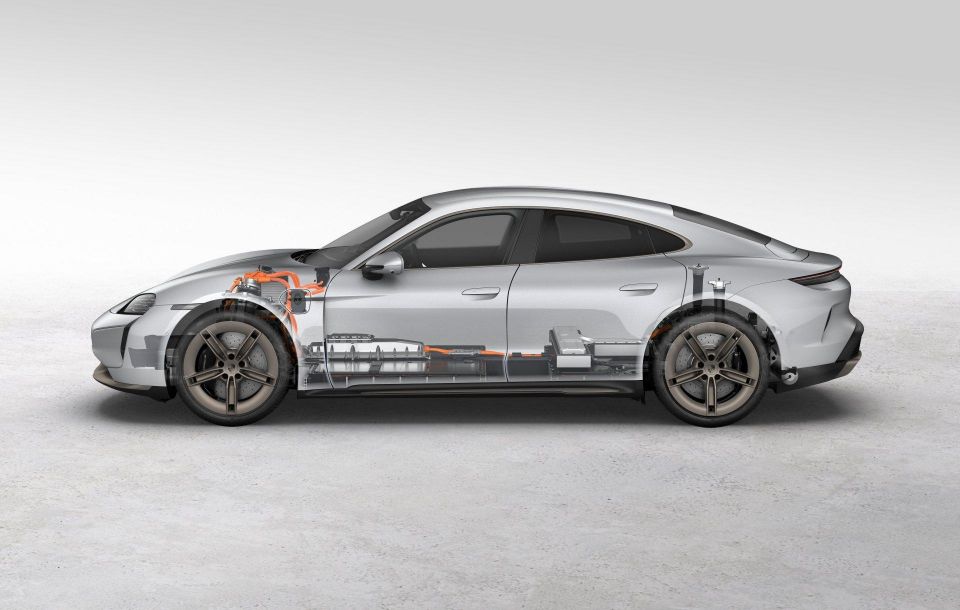
2024 Porsche Taycan performance figures:
| Variant | Power | Torque | 0-100km/h (seconds) | Range | Battery |
|---|---|---|---|---|---|
| Taycan | 300kW | 410Nm | 4.8 | 590km | 89kWh |
| Taycan PBP | 320kW | 420Nm | 4.8 | 678km | 105kWh |
| Taycan 4S | 400kW | 695Nm | 3.7 | 557km | 89kWh |
| Taycan 4S PBP | 440kW | 710Nm | 3.7 | 642km | 105kWh |
| Taycan Turbo | 650kW | 940Nm | 2.7 | 630km | 105kWh |
| Taycan Turbo S | 700kW | 1110Nm | 2.4 | 630km | 105kWh |
2024 Porsche Taycan Cross Turismo performance figures:
| Variant | Power | Torque | 0-100km/h (seconds) | Range | Battery |
|---|---|---|---|---|---|
| Taycan 4 CT | 320kW | 610Nm | 4.7 | 613km | 105kWh |
| Taycan 4S CT | 440kW | 710Nm | 3.8 | 610km | 105kWh |
| Taycan Turbo CT | 650kW | 940Nm | 2.8 | 597km | 105kWh |
| Taycan Turbo S CT | 700kW | 1110Nm | 2.5 | 596km | 105kWh |
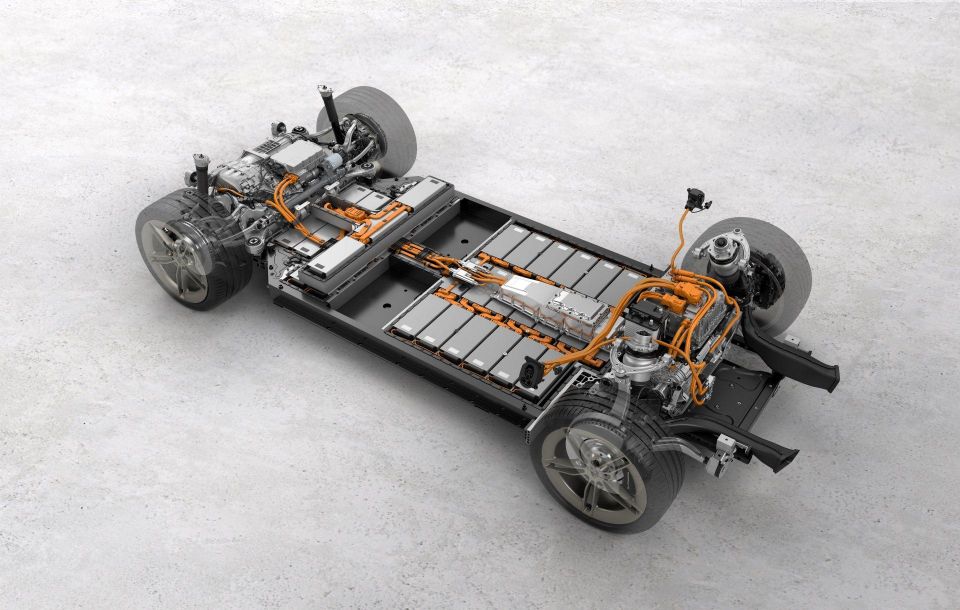
The 34 per cent improvement to claimed range is due to a variety of reasons, which Porsche breaks down as such:
As an example, replacing the previous-generation 21-inch Mission E wheels with the same-sized Aero design wheels with distance tyres has added 40km of range alone.
The new Taycan is also now able to recapture power at a higher rate. The rate of deceleration at which it could capture energy has increased from 3.8m/s² to 4.5m/s², and power capacity for that capture has increased from 290kW to 400kW.
Perhaps a little less relevant to Australian buyers who would charge at home, but the increase recharging rate of 320kW also means the Taycan can go from 10 to 80 per cent charge in just 18 minutes (previously 21.5 mins). A quick 10-minute charge on a fast charger will give you 315km of range.
The new Taycan is now able to cool the battery at 1.3°c/min (previously 0.8°c/min) with more cooling power (12kW vs 9kW) and it’s a similar story for heating the battery, with rate of heating doubled to 0.8°c/min with 17kW of power (vs 7kW).
Worth noting that AC charging has actually been downgraded to 11kW from 22kW on the previous generation, this is unlikely to affect any buyers as home chargers are seldom able to supply more than 11kW.
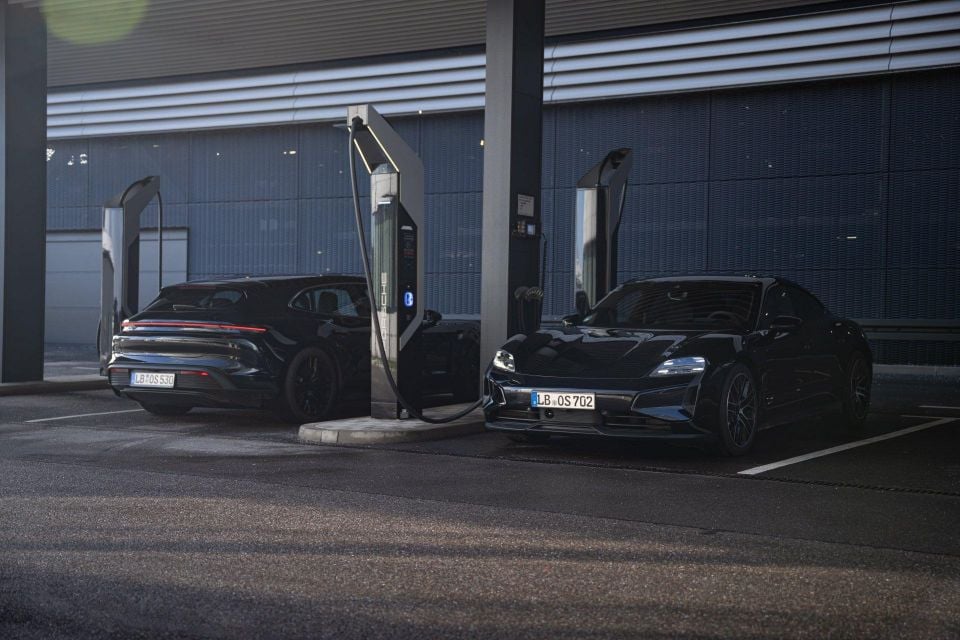
Battery improvements details:
| Original Taycan | New Taycan | Change | |
|---|---|---|---|
| Energy HVB gross | 93.4kWh | 105kWh | +12% |
| Max Charge Current | 336A | 400A | +20% |
| Min Start Temperature Fast Charge | 35°C | 15°C | -20°C |
| Max Current for Launch Control | 860A | 1100A | +20% |
| HVB weight | 634kg | 625kg | -9kg |
| Energy density gross | 148.7 Wh/kg | 168.3Wh/kg | +13% |
Every single variant of the Taycan coming to Australia has been vastly improved to be faster and deliver better all-around performance. Porsche has made adaptive air suspension (with valve damper technology) standard across the entire range.
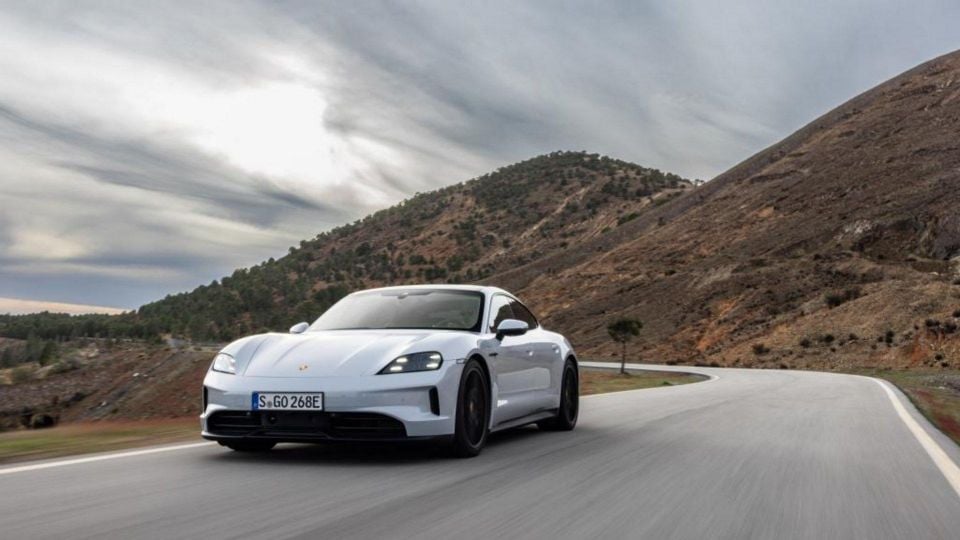
The chunk of the performance upgrade comes from the new rear-axle motor which adds an additional 80kW of power across the entire range, while an enhanced pulse inverter, larger batteries, improved heat management thanks to a new heat pump have increased both performance and efficiency elsewhere.
During the international launch, we drove the Taycan 4S and the Taycan Turbo Cross Turismo – we also drove the ballistic Turbo GT which can do 0-100km/h in an insane 2.2 seconds, our review for that comes out next week.
Having spent a fair bit of time in the original Taycan, the argument for the car has always been pretty simple. No one really needs a Taycan that is faster than the base model – which is now substantially faster still, but Porsche has never been about answering the needs, but rather the wants of its customers.
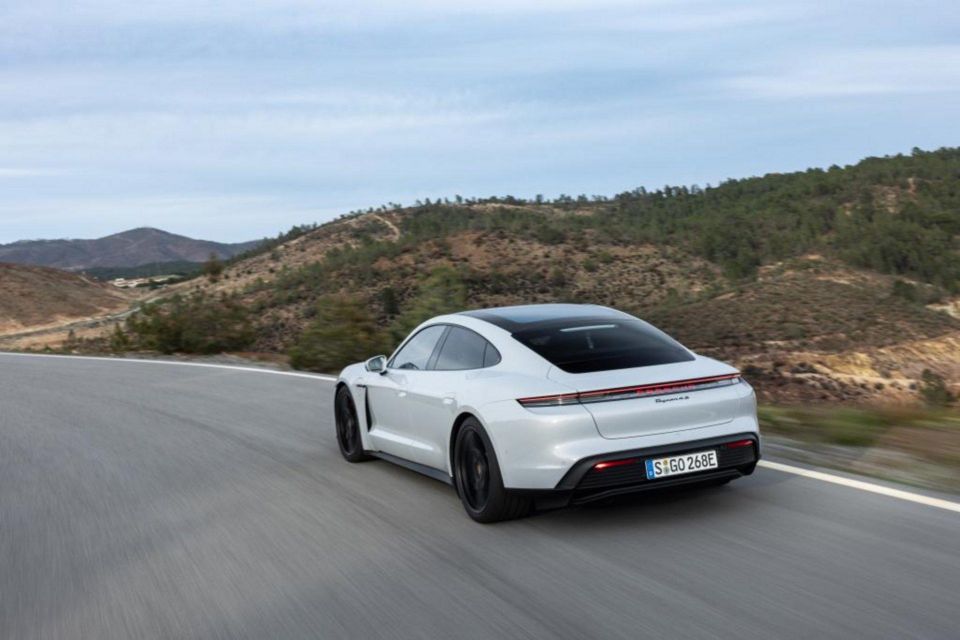
The Taycan 4S being able to 3.7 seconds to 100km/h is a little absurd, to be frank. It just doesn’t need to be this fast, but it is. This is very much supercar territory and to think that you can now buy a Taycan Turbo GT that is capable of 2.2 seconds to a 100km/h – quicker than a Formula 1 car (mainly due to traction) – is a scary thought.
Acceleration figures in the age of electric performance cars are fun to discuss, but a little irrelevant. Tesla proved years ago that going fast in a straight line is all well and good, but unless you live in the deep south of the United States, capacity to take corners is now more important than ever when it comes to enjoyable EV ownership.
The good news is the new Porsche Taycan improves on what was already a best-in-class package. The new suspension system (you can also option up the Porsche Active Ride) reduces body roll noticeably and despite weighing somewhere between 2090kg (unladen weight DIN: Taycan) and 2325 kg (unladen weight DIN: Taycan Turbo S Cross Turismo), the Taycan behaves like a Porsche should.
If you are coming in and expecting GT3 levels of cornering performance you will be disappointed. Nonetheless, given this is a large four-door sedan, it will still keep up with most things around tight twisty roads, so long as you can manage the weight transfer and plan your braking points.
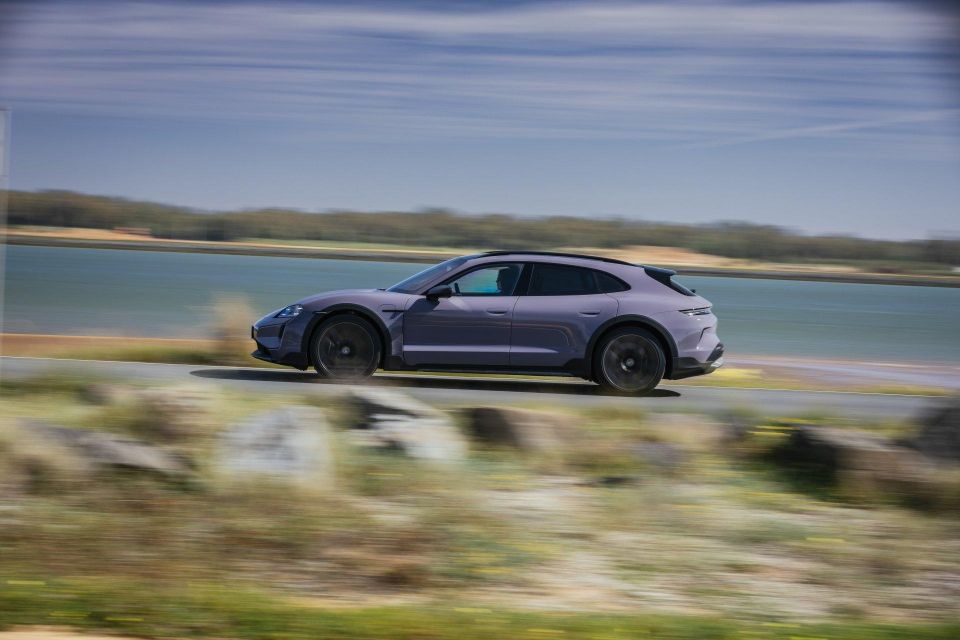
Unlike, say a Cayman or 911 whereby cornering speed is pivotal to keep the RPMs up, in the Taycan you can give up a bit of speed on the corner entry and get it back on the exit given just how quickly it can accelerate.
In some ways it’s like driving an electric go kart – your reliance on absolute momentum in the corners is not as vital as an internal-combustion engine (ICE) vehicle that needs to keep its revs high for maximum power and torque delivery.
Porsche has stuck with its two-speed transmission (on the rear axle, front remains a single gear) which engineers told us can now keep first gear until 140km/h and you can find it noticeably changing with big bursts of acceleration. It feels less clunky than before.
One cannot imagine a situation in which a buyer can get into a new Taycan (in any variant) and question its performance credentials. The car is fast and has the means to grip around bends with relative ease.
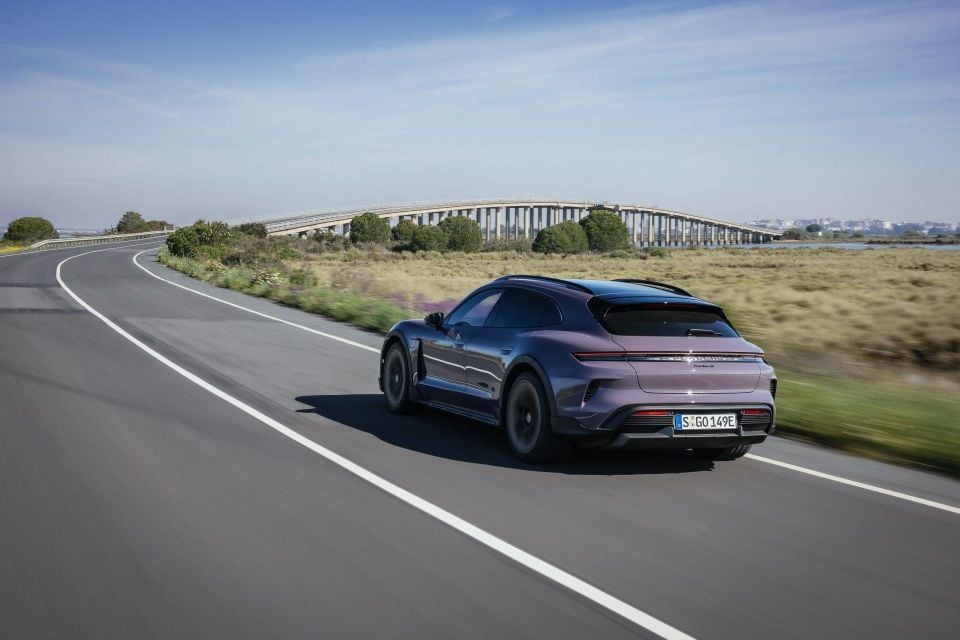
What it lacks though is a bit of character and sound. While Porsche has added a new noise for the Turbo models to distinguish them from the lower variants, it still emits a futuristic sound that tries very hard to tell you its electric.
Given the world has moved on and no longer cares as much if your car is electric or not, it would certainly enhance the driving experience if Porsche added a few more options for ‘engine’ noise. Yes, we are advocating for fake sound because it would improve the ownership experience.
Since there is a ‘Turbo’ badge on the back of a Taycan without anything even remotely resembling a turbocharger inside, there is no harm in adding a more enjoyable driving noise. This is arguably a very personal opinion, however, and many would like to keep their car as silent as possible.
We drove the Taycan range through some of the best roads offered in Spain, which meant there was almost no potholes or uneven surfaces, making it difficult to give an Australian-relevant assessment on ride quality, but given the new air suspension system, it should only serve as an improvement.
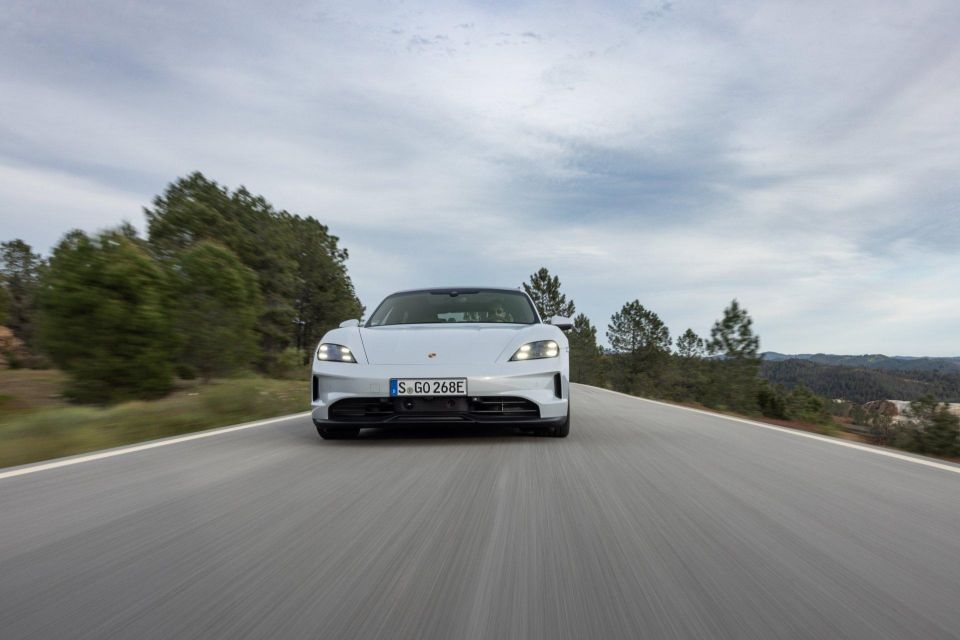
As with all electric performance cars, the party trick of accelerating really fast wears thin after a while. Your passenger will smile the first few times but probably ask for a sick bag if you keep using launch control.
It’s with that thought we think the base Taycan with or without the performance battery is the ideal car in the range given it will spend almost none of its life being driven like a GT3 and is still a very fast 4.8 seconds to 100km/h.
The interior of the Taycan presents as a very modern yet usable cabin with comfortable seats and the latest in-car technology.
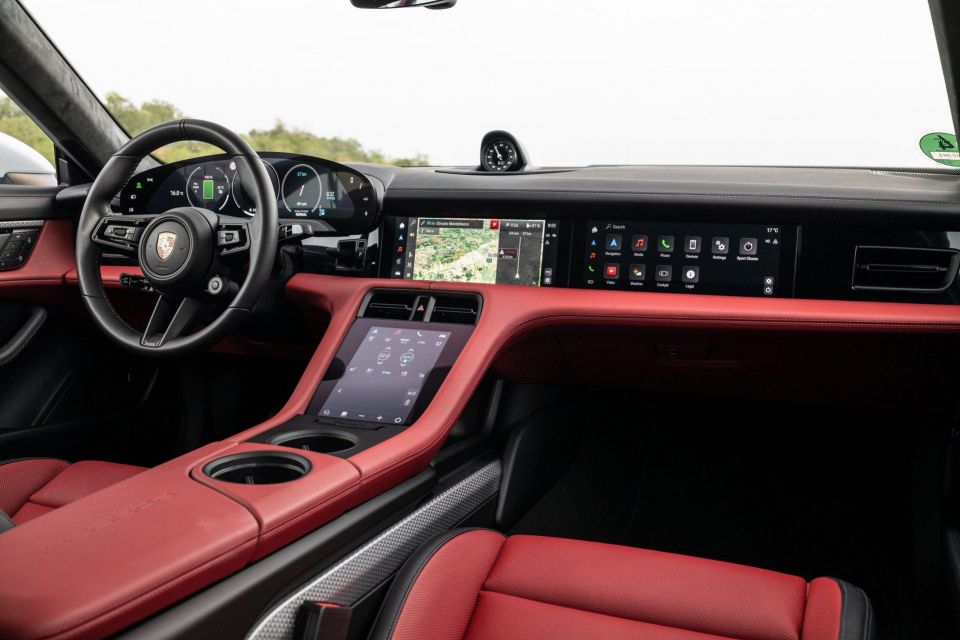
Where expert car reviews meet expert car buying – CarExpert gives you trusted advice, personalised service and real savings on your next new car.
Although it appears to be relatively unchanged at first glance, Porsche has upgraded some of the screens with a better charging screen, a revised drive assistance concept layout and software enhancements to the centre display.
Passengers can now also stream videos on their own display while the vehicle is moving (this can’t be viewed from the driver’s seat).
The wireless phone charging system has also been uprated to 15W and offers cooling (note that iPhones need a MagSafe-approved device to charge at that speed, which in our testing didn’t seem to be the case for the new Taycan).

In total, there is a 16.8-inch curved screen, backed up by a central 10.9-inch infotainment display and an optional passenger display, as well as a 8.4-inch touchscreen under the central air vents. If you option the four-zone climate control, that adds a further 5.9-inch touchscreen for the rear seat passengers.
Perhaps the best usability improvement to the Taycan has been the enhancement to wireless Apple CarPlay, which now integrates with Porsche’s own system far more seamlessly.
With the new system CarPlay can control the temperature and the direction of air conditioning system, meaning you don’t have to keep crossing back to the the native Porsche system to change basic car functions.
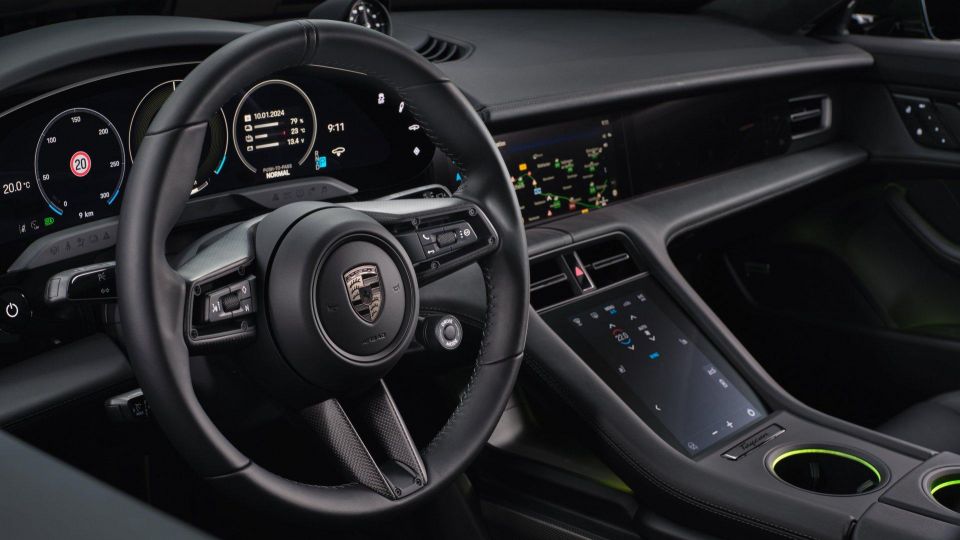
We found the front seats in both the 4S and the Turbo to be supportive and comfortable. The natural four-seater configuration of the Taycan allows for the rear passengers to sit in comfort with excellent leg and head room. If you desperately need the additional fifth seat, it can be had for about $1000 but it’s still best suited to a child…
The boot size of the standard Taycan is 407L while the Cross Turismo fits 446L, both figures are slightly reduced with the Turbo models.
The original Porsche Taycan achieved a five-star Euro NCAP crash rating back in 2019, though there’s no data on the new model available yet.
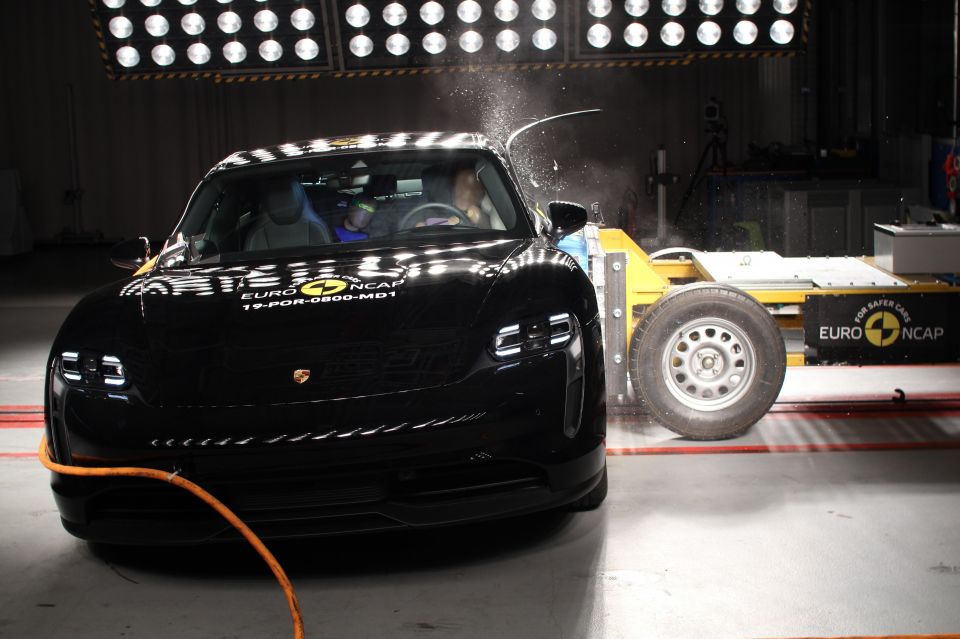
As with the original car, the updated Taycan has eight airbags and has been engineered from the ground up to take crash safety into account from an EV perspective.
As such, the battery modules are built into a lightweight aluminium battery frame structure to reduce the risk of exposure in the event of a crash. Furthermore, the crash sensors disconnect high-voltage equipment in the event of a crash.
If any airbag was to deploy, the battery is automatically disconnected from the motors as a precaution. Porsche says several high-voltage disconnection points in the Taycan allow first responders to act quickly, with the fuses, busbars and the battery management system, including the disconnection unit, all located in a protected area in the centre console.
Porsche Australia offers a three-year, unlimited-kilometre warranty across its entire lineup.
Serving pricing varies by dealership and is tailored individually depending on requirements and vehicle condition. This has not changed from the previous model.
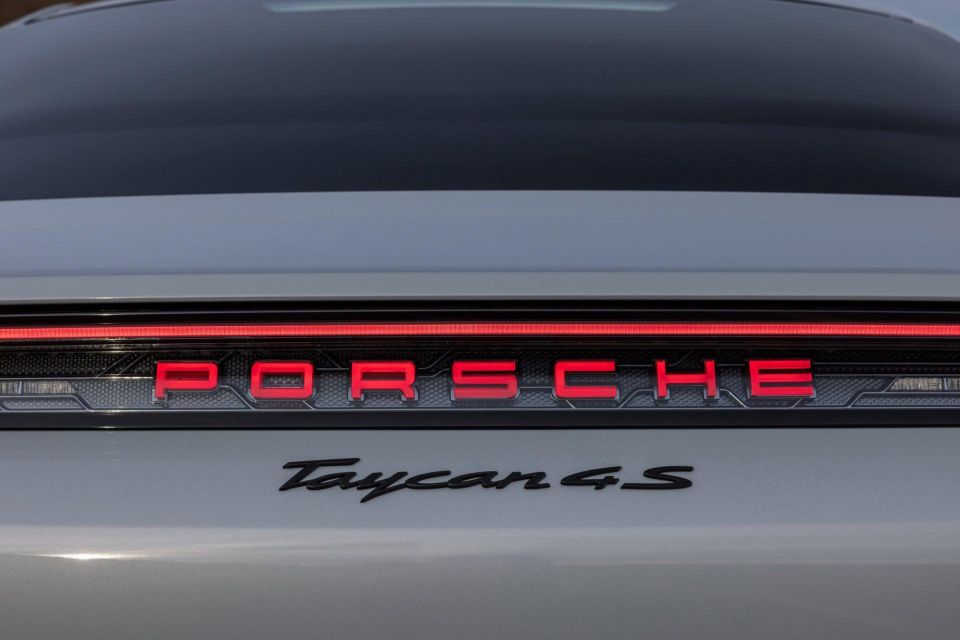
The Taycan is covered by an eight-year/160,000km warranty on the high-voltage battery. Logbook servicing is required every 12 months or 15,000km, whichever comes first.
The 2024 Porsche Taycan has once again reset the benchmark in the segment.
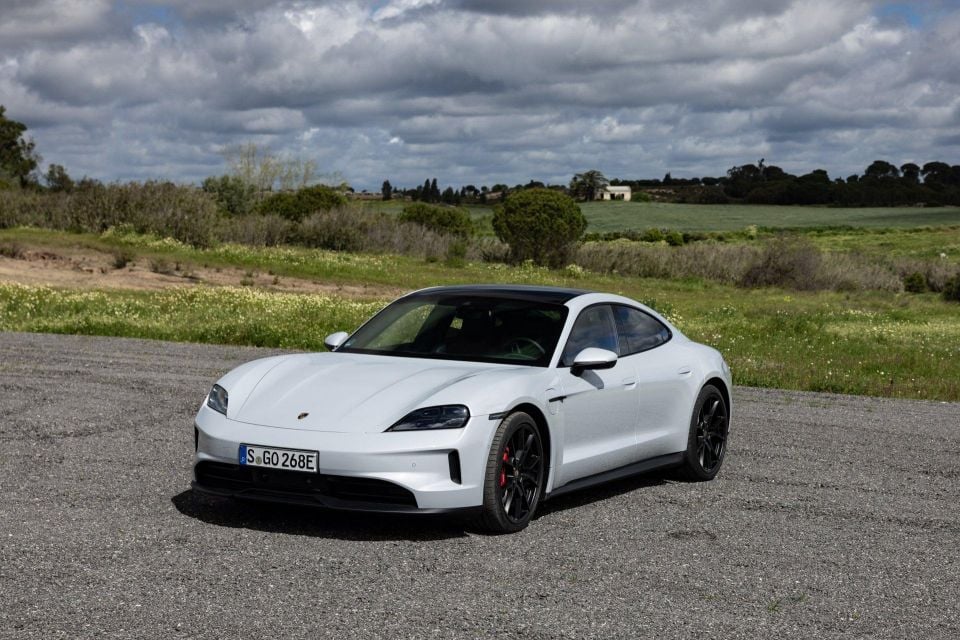
It’s what a Tesla Model S wished it could be, and it’s the car that every other EV makers uses to understand how to make an electric car handle and behave like a traditional sports car.
In many ways, this new Taycan should appeal not only to those looking to buy their first premium and genuinely sporty EV, but also to existing Taycan owners who are looking for a substantial upgrade – because as it stands today, there is nothing quite like it.
You won’t regret a Taycan purchase and the only word of advice we could pass on would be to go for a lower-spec model. The roughly $100,000 difference between a 4S and a Turbo doesn’t change your life like it does in a 911.
Yes it’s faster, but it’s not a holistic experience change that you get from the internal combustion engine vehicles. It’s an expensive party trick upgrade that will wear off quickly.
Subsequently, also be aware that current model Taycans have depreciated (a lot) more than other Porsche models, so make sure you do your best to get a great deal on a new one to avoid disappointment when it comes to resale.

Click the images for the full gallery
MORE: Buy a Porsche Taycan MORE: Everything Porsche Taycan
Where expert car reviews meet expert car buying – CarExpert gives you trusted advice, personalised service and real savings on your next new car.
Alborz Fallah is a CarExpert co-founder and industry leader shaping digital automotive media with a unique mix of tech and car expertise.


William Stopford
20 Hours Ago


William Stopford
2 Days Ago


CarExpert.com.au
5 Days Ago


Damion Smy
7 Days Ago


Damion Smy
10 Days Ago


Max Davies
11 Days Ago